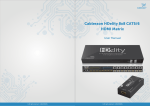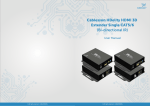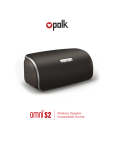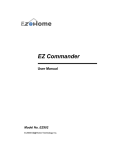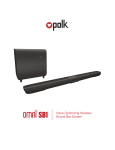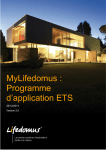Download Audio Authority 2811 Specifications
Transcript
HDelity OverIP EX Index 1. INTRODUCTION 2. HDMI TECHNOLOGY 3. CHECKING PACKAGE CONTENTS GETTING THE BEST RESULTS 4. APPLICATIONS 5. INSTALLATION DISTRIBUTION USING MULTIPLE SOURCES CONNECTING THE HARDWARE IR PASS THROUGH 6. SPECIFICATIONS 7. TROUBLESHOOTING HDMI TECHNOLOGY The Old: Standard HDMI® devices transmit video and audio using a signaling method called TMDS (Transition Minimized Differential Signaling). TMDS was designed for short cable runs, like those necessary to connect a cable box to an HDTV in an entertainment center. Unfortunately, TMDS has some limitations. Very high frequency signals like HDMI tend to “roll off” as cable runs get longer. Since differential pairs are used for each of the three color channels and the separate clock channel, differences in individual wire lengths inside HDMI cables can cause timing errors and blank screens. The New: HD-IP technology utilizes Ethernet standards to overcome the inherent limitations of TMDS. Enabling totally reliable cable runs up to 250 feet long, easy distribution of signals, and robust signal integrity, transmitting HDMI signals over IP networks redefines the possibilities for HDMI video distribution. Compliant with HDCP 2.0 specifications, this technology supports copy protection with 128-bit AES encryption and overcomes traditional key verification limitations, enabling very large system sizes while maintaining full HDCP compliance. Audio Authority’s Gigabit infrastructure means that the picture quality is virtually indistinguishable from the source, suitable for the most discerning viewer. SYSTEM FEATURES • Gigabit Ethernet (GbE, 1000BASE-T) technology for better picture quality • Uses off-the-shelf GbE network switches for distribution • Requires only one UTP cable per position (Cat 5e or Cat 6) • Quick synchronization means maximum up-time • Installation is plug and play – no complex setup routines or programming • Designed to function on a separate, dedicated Ethernet network • Cat 5e max. distance: 200+ ft. (60m), Cat 6 max. distance: 250+ ft. (75m) • Cascading multiple network switches and cable runs allows maximum distribution distances of 1000+ ft. (300m) when necessary • HDMI version 1.3 and HDCP version 2.0 compliant • Supports 720p and 1080p and embedded digital audio (2-channel PCM) • IR can be transmitted over the UTP cable back to the source location • Maximum number of sinks is 127 with HDCP protected content 1 HD Multimedia Product Series Before connecting the 2800 system, please make certain the following items are in the shipping cartons. Note: the 2801 and 2811 are sold separately. 2801 Transmitter x1 2811 Receiver x1 5V DC Power AdaptersR x1 User Manual x1 Product Specification Dedicated network. Resolution tracking. The 2800 Series is designed to operate on a dedicated Set up the source to output the best resolution that all TVs Gigabit Ethernet network, not to be combined with other are capable of displaying. The 2800 Series supports 720p network traffic or with access to the internet. and 1080p. If some TVs in the network are not capable of accepting 1080p, the higher resolution sets may not be Source resolution and video/sound quality. shown to their best advantage. Sources, such as satellite receivers or cable boxes, can Display devices output at low resolutions or deliver extremely compressed video material, yielding poor results. Consider the source The perceived quality of the video image depends heavily when planning and troubleshooting your system. upon the type and quality of the TVs or projectors used. High quality displays should be expected to produce a Distance between the transmitter and the receiver. noticeably better image. Long distances are possible, but premium quality Cat 6 Source and TV connection cables. cables are necessary for the longest runs. Use short, premium HDMI cables; low quality cables are Interference from nearby electrical devices often unreliable. Always use good strain relief methods or can have an adverse effect on signal quality. For example, locking cables to prevent cables from becoming loose over older computer monitors often emit very high electromag- time. netic fields that can interfere with the performance of nearby APPLICATIONS video equipment. The 2800 Series is designed primarily for digital signage and showroom TV wall displays. It can be used in two main ways: as an extender (point to point) and as a distribution system (one to many or many to many). 2 GETTING THE BEST RESULTS Many factors influence the quality and reliability of an HDMI® signal distribution installation. The following are the main factors to consider, and basic precautions that will ensure the best possible performance. 1. Dedicated network. The 2800 Series is designed to operate on a dedicated Gigabit Ethernet network, not to be combined with other network traffic or with access to the internet. 2. Resolution tracking. Set up the source to output the best resolution that all TVs are capable of displaying. The 2800 Series supports 720p and 1080p. If some TVs in the network are not capable of accepting 1080p, the higher resolution sets may not be shown to their best advantage. 3. Source resolution and video/sound quality. Sources, such as satellite receivers or cable boxes, can output at low resolutions or deliver extremely compressed video material, yielding poor results. Consider the source when planning and troubleshooting your system. 4. Display devices. The perceived quality of the video image depends heavily upon the type and quality of the TVs or projectors used. High quality displays should be expected to produce a noticeably better image. 5. Distance between the transmitter and the receiver. Long distances are possible, but premium quality Cat 6 cables are necessary for the longest runs. 6. Source and TV connection cables. Use short, premium HDMI cables; low quality cables are often unreliable. Always use good strain relief methods or locking cables to prevent cables from becoming loose over time. 7. Interference from nearby electrical devices can have an adverse effect on signal quality. For example, older computer monitors often emit very high electromagnetic fields that can interfere with the performance of nearby video equipment. 3 EXTENSION In extension applications, the transmitter may be connected directly to the receiver, for distances up to 250 ft. (75m), using Cat 6 cable. A GbE network switch can be added in the Cat 6 path to double that distance. Personal Computer Blu‐ray DVD LCD / LED TV HD Projector RS3 / XBOX Video Video Camcorder HDMI Splitter HD Recorder HDMI Switch HD A/V player A/V Amplifier DLP MOD / Cable TV KKBox / Tivo Pico Projector Home System 5 meter HDMI Output Cable (Bypass Out) 5 meter HDMI Input Cable (HDMI input) Transmitter (2801) Receiver (2811) CAT 6 CABLE UP TO 250 FT. LCD/LED Projector Blu-ray/ Dvd Transmitter (2801) Receivers (2811) CAT 6 CABLE UP TO 250 FT. LCD/LED Projector Blu-ray/ Dvd GbE SWITCH 2811 and TV 2811 and TV 2811 and TV 2811 and TV 2811 and TV 4 DISTRIBUTION USING MULTIPLE SOURCES The HD-IP system uses virtual LAN technology to distribute multiple SOURCE CH 2801 DIP 2811 DIPs source signals on the same network – a managed switch is not required. To use multiple sources on one network, each source Blu-ray Disc 1 1=ON 1=ON must have its own virtual LAN or “channel” as designated by DIP Satellite DVR 2 2=ON 2=ON Video Server 3 3=ON 3=ON Game Console 4 4=ON 4=ON switches on 2801 and 2811. Power down the system and set the DIP switches as shown. Apply power to activate the settings. In this example, multiple 2811s all set to channel #1 receive signals from the Blu-ray player, while 2811s on channel 2 receive signals from the Satellite DVR. GbE SWITCH Blu-ray 2811 CH 3 2811 CH 2 2811 CH 1 GbE SWITCH 2811 CH 4 Transmitter (2801) GbE SWITCH 2811 CH 4 GbE SWITCH 2811 CH 2 CAT 5E/6 Game Console+2801 LCD/LED Projector Satellite DVR+2801 Video Server+2801 Receiver (2811) INSTALLATION Before connecting the 2800 system, verify that all display devices on the receiving end can support the output resolution and signal format from the source by connecting it directly to the source device via a short, known good, HDMI cable. CAT 5E/6 CABLES To terminate Cat 5e or Cat 6 cables, use standard EIA-568A or B pairing. Correct pairing is vital, and should always be checked with a network cable tester. The correct pairing is straight through, pin-to-pin, as shown. 5 1 2 3 4 5 6 7 8 WHITE / ORANGE ORANGE WHITE / GREEN BLUE WHITE / BLUE GREEN WHITE / BROWN BROWN 1 2 3 4 5 6 7 8 WHITE / ORANGE ORANGE WHITE / GREEN BLUE WHITE / BLUE GREEN WHITE / BROWN BROWN CONNECTING THE HARDWARE Transmitter (2801) Receiver (2811) 1. Determine DIP switch settings if appropriate ( Using Multiple Sources). 2. Connect the HDMI® source device’s output to the HDMI INPUT connector of the 2801 Transmitter, using a short, high quality, HDMI cable. 3. Connect a correctly terminated and tested Cat 5e/6 cable to the ETHERNET connector of the Transmitter. Do not connect the AC adapter until the UTP cables are correctly connected to both the transmitter and the receiver. Again, always test the HDMI source on the intended display with a known good HDMI cable before connecting the distribution system. This precaution insures that the source can be (and is) set to a resolution that is 4. Compatible with the display, and that both are functioning correctly together. At remote locations, connect the appropriate UTP cable to the ETHERNET connectors of the 2811 Receiver. 5. Connect the HDMI OUTPUT of the 2811 to the HDMI input of the video display or other device, using the appropriate cable. Connect IR equipment (if used) at this time – see below. 6. Connect the supplied AC adapters first to the 2801 Transmitter and 2811 Receivers (and to any Ethernet Switches) and then to the AC outlets. 7. Turn on the source device and video displays. The source video signal should appear on the displays. If not, consult the Troubleshooting guide. 6 IR PASS THROUGH IR signals can be passed from the 2811 Receiver location(s) back to the 2801 Transmitter location (single Transmitter systems only) to control the source equipment. The HD-IP system may not be compatible with all IR equipment. Note: IR signals cannot be passed reliably when more than one 2801 Transmitter is used in a network. 1. With power disconnected from the 2811 Receiver, Tip Tip==Signal Signal = Gnd RingRing = Ground Sleeve = +5V Sleeve = +12 Volts connect a standard IR receiver to the 2811’s 3.5mm IR port. Pin out is shown below. 2 Tip =Tip Signal = (+) Ring = Ground = (–) Sleeve =Sleeve +12 Volts With power disconnected from the 2801 Transmitter, connect a stan- IR RECEIVER IR EMITTER dard IR emitter to the 2801’s IR (2811 CONNECTION) (2801 CONNECTION) 3.5mm IR port. Pin out is shown. SPECIFICATIONS DIGITAL AUDIO/VIDEO I/O CAT 5E/6 CONNECTIONS I/O 2801 Transmitter 2801 Transmitter 1x via HDMI connector – HDMI input 1x via RJ-45 – Cat 5e/6 output 2811 Receiver 2811 Receiver 1x via HDMI connector – HDMI output 1x via RJ-45 – Cat 5e/6 input VIDEO PERFORMANCE AUDIO PERFORMANCE Minimum resolution: 720p Digital Audio Maximum resolution :1080p (1920x1200, 1080p/60Hz) 2-channel PCM audio only TMDS clock speed *: 225MHz ENVIRONMENTAL Data bit rate *: 2.25Gbps Maximum range : 250 ft. (75m) direct connection Operating Temperature 1000 ft. (300m) via GbE switches 0° to +50° C (+32° to +122° F) Operating Humidity REGULATORY APPROVALS 10% to 90%, Non-condensing Transmitter (2801) and Receiver (2811) Storage Temperature HDMI, HDCP, RoHS -10° to +70° C (12° to +158° F) Power Supply Storage Humidity UL, CUL, CE, PSE, GS, RoHS 10% to 90%, non-condensing MECHANICAL Dimensions: H-W-D inches (mm) 1.25 x 6.35 x 4.5 (32x162x115mm) 7 NETWORK REQUIREMENTS ACCESSORIES INCLUDED Cat 5, Cat 5e or Cat 6 Power Adapter, 5 VDC@2A, User Manual Network grade, premium WARRANTY Network Switch Compatibility Limited Warranty: Standard Gigabit Ethernet 1000BASE-T network switch 1 year warranty TROUBLESHOOTING 1. Poor image quality: Some sources, such as cable and satellite receivers, compress output resulting in poor image quality. Connect the source directly to a display via a short HDMI® cable to compare. The 2800 Series does not require any adjustment. 2. Intermittent signal dropout: make sure the 2800 Series is not connected to any other devices, or sharing a network with other traffic, especially with access to the internet. Make sure all 2801 transmitters are set to a unique “channel” (see page 7). Also make sure no AC wiring is installed within two feet of the 2800 Series network cables. 3. No surround sound (multi-channel audio): this system does not support multi-channel digital audio transmission; adjust the source to output 2-channel PCM digital audio. 4. No picture: perform the verifications below. a) Check the HDMI cables at input and output connections to see if any of the connectors have become loose. b) Make certain 2801 and 2811 units are connected to live AC outlets and check the power indicators on all units. c) Use a network cable tester to make certain your Cat 5e/6 cable is terminated correctly and the RJ-45 connectors are securely attached to the cable at both ends. Check for cable defects or damage. d) Connect the display device directly to the source using the HDMI cable from the 2801 end, then test with the 2811 connection cable. If an image is present under those circumstances then the display, the source, and the HDMI cables can be eliminated as the cause of the problem. e) If the above circumstances do not produce a picture, test using a short, known good HDMI cable, and set up the source to output a resolution that the display can accept. If this test is successful, connect the 2800 Series again, making sure the source resolution is the same as the test. If you encounter difficulty, contact the HDelity Technical Service via email: [email protected], or call 01865-253-790 8











